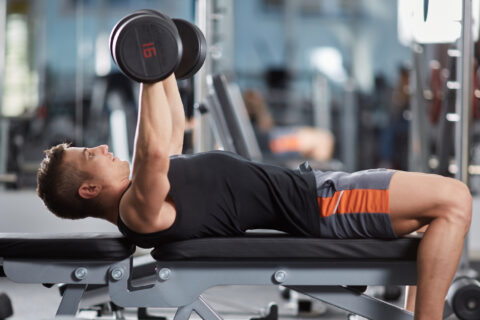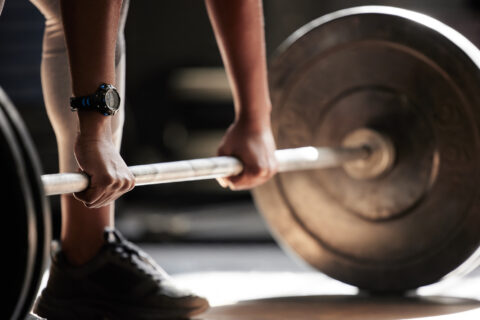In Week 2 of our strength training series, coach and physiologist Ryan Kohler introduces some new exercises that will prioritize different muscle groups, challenge your movements, and help you find new ways to develop your strength. There are five exercises in total: front squats, deadlifts, barbell back squat, push-ups, and rows. In some exercises, the weight and repetitions have been changed to accommodate the additional movements and to build up volume progressively. As with every week in this series, try not to rush things. If you find that you could take some time to refine movements, stick with any given week longer and be sure to focus on movement quality first, weight second.
Did you miss Week 1? Catch up now! Fast Talk Labs’ Strength Training Series: Week 1
Week 2 workout at a glance
Front Squat: 3-4 sets of 8-10 repetitions
Deadlift: 3-4 sets of 10-12 repetitions
Back Squat: 3-4 sets of 10-12 repetitions
Push-Ups: 2-3 sets of 8-10 repetitions
Bent-Over or Seated Row: 2-3 sets of 10-12 repetitions
Before getting started, be sure to warm up well with our Warm-up & Activation Routine.
Progressions and regressions
Front Squat
To regress your front squat, put the barbell away and grab a pair of dumbbells or kettlebells. These will be easier to work with from a weight and mobility perspective as you can adjust arm position to limit the high elbow and extended wrist for added comfort. Hold these around your shoulder position and work on your body mechanics without having to worry about balancing a larger bar in front of the body.
Deadlift
To make the deadlift easier, as with other barbell movements, I usually recommend getting rid of the bar first. Use bands under your feet or grab a pair of dumbbells. Use the regression from Week 1 to refine your movement before moving back to the bar again.
Back Squat
Similar to the deadlift, let’s put the bar down and work on the fundamental movements safely by utilizing dumbbells, kettlebells, or bands. You can tuck an exercise band under your feet and get into the same position to promote the same focus on quality movement and good form.
Bent-Over or Seated Row
If you lack access to a bench for the “bent over” version, simply grab an exercise band and wrap it around something stable so you can do a standing or seated version. You can progress these by moving to single-leg rows or involving some unstable surfaces.
Push-Up
If the full push-up position is too difficult, you can regress this movement and focus on good mechanics by going from your feet to your knees. This will reduce the amount you’re lifting. Alternatively, you can remain on your feet, but elevate your shoulders above the feet and hips, essentially moving into more of a forward leaning posture. To progress your push-ups and make them more challenging, you can do a few things:
- At the top of your push-up, rotate at the hips and move into a full side plank.
- Elevate one foot off the ground to challenge your stability.
- At the bottom of the movement, fully remove your hands from the ground (i.e., “hands off” push-up), place them back on the ground, and then push up strongly from that position.
Pitfalls and warnings
Front Squat
- Leaning forward: Not only is this dangerous as the bar can fall forward and off the front of your body, but it also puts undue strain on the back. Be sure to keep an upright/tall posture throughout the movement.
- Moving the knees forward first: Be careful of your movement here, and ensure the hips move back first. This will protect the spine and help you to progress easier over time.
- Dropping the elbows: As this motion has a specific posture to maintain, be sure you can keep a high-elbow position to maintain safety and stability with the bar. If you notice your elbows dropping, try changing up your position by using a crossed-arm grip. If that doesn’t work, you can use a towel to help keep the bar supported while maintaining your mobility. Finally, if those methods are uncomfortable, simply go back to dumbbells or kettlebells or reach out to a certified strength coach or physical therapist to help with potential movement errors or improvements in mobility.
Push-Up
- Drooping or piked hips: Ask for help or check in the mirror to notice if your hips are drooping or extending toward the ceiling. If you notice that you’re losing that strong, stable posture from the ears through the ankles, reduce the time you’re holding or ask for feedback, so you know when to refocus your posture. I always think about locking into that strong posture from head to toe before every “push” upward and it helps ensure I’m moving from the right place and firing the correct muscles.
- Head position: Be careful, especially as fatigue builds in, to keep your head in a neutral position. Sometimes when we’re tired it’s easy to start craning the neck down as we struggle with those last couple of reps. This is the time to really refocus on your position. Don’t rush the reps. As with the other exercises, do as many as you can with good form and when you notice form falling away, it’s time to take a break.
Video Transcript
Ryan Kohler 00:00
Here in week two, we’re going to add a few new exercises for you, there may still be a little bit of residual soreness from last week. These two new exercises will hit slightly different muscle groups: the front squat that we’ll do will target a little bit more of the quadriceps, and then we’re going to add in a pushing exercise to complement the pulling that we did in the previous week. With that, again, new exercises focus on form over weight, let’s go head over and do our front squats.
Front squats
Ryan Kohler 00:31
Here in week two, we’re looking at our front squat, and we’re doing three to four sets of eight to 10 reps. We’ll come up to the bar here, and the idea with this is to have our grip a little bit closer together. But again, find what feels comfortable for you. We’re going to let that bar roll right up onto the front of the shoulders here. Then we’re going to step away with it slightly from the rack, and then get our feet comfortably wide apart, I like to go a little bit more than hip width.
One of the keys with this exercise is to keep a relatively upright torso. You want to have these elbows pointing high. You don’t want to end up trying to squat like this, have them up high and tall. This also involves a lot more of the core when you try to stabilize this way. From here, we’re going to start by moving the hips back to start that descent. We shift those hips back, descend down toward the floor to a comfortable position, and then drive back up finishing with a strong hip drive at the top.
If you find that you have any issues with risk mobility, or shoulder mobility or just discomfort when you try to get into this position, you can change your grip. What you’ll do there is just walk into the bar this way, allow it to sit kind of on the front of the shoulders there and then cross your arms over and lift up and step back this way. That way your wrists are free and you can still maintain that nice tall upright position.
Deadlifts
Ryan Kohler 01:50
Now we’ll do the deadlift, three to four sets of 10 to 12 reps.
Barbell back squat
Ryan Kohler 02:11
All right, so we’re going with the barbell back squat three to four sets 10 to 12 reps.
Push-ups
Ryan Kohler 02:36
This next exercise is your classic push-up, we’re looking at two to three sets of eight to 10 reps. One of the keys with this is that we want to have a nice athletic posture for this, it’s easy to do these wrong. Think about letting your shoulders come down and back when you start them. From there, I’m going to show you three different variations: regular variation, progression and regression. Here we go!
We’re going to start here with our shoulders generally over our hands in a nice full push up-plank position here. One thing to avoid is letting the hips drop like this, or go into more of that down dog position. From here, we’re just going to lower ourselves down and then come right back up. Now if that’s too difficult to start, we can regress this, have you gone to your knees and perform the same movement. Alternatively, if you want to make this more difficult, you can go up in your push-up position as you go down. You can fully release the hands and then press back up strongly. Here we go.
Row
Ryan Kohler 03:49
Okay, now we’ve got our row, two to three sets 10 to 12 reps.
That’ll do it for us in week two. Look forward to next week where we’ll bring in a few new exercises and we’ll see you then!



